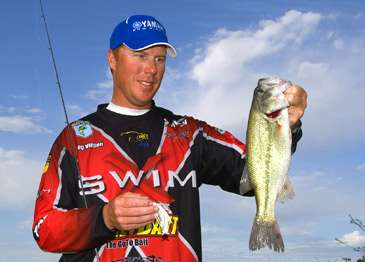
As the 2009 Bassmaster Elite season nears the midway point, a surprising technique that's been around for decades may become the hottest tactic of the year.
The pros have been swimming jigs, fishing them 8 to 10 inches under the surface over submerged vegetation, around laydowns and through other shallow cover — and they're catching a lot of bass.
"It's an alternative to spinnerbaits," explains Elite pro Greg Vinson, who's been using the technique for 10 years on Alabama's Coosa River lakes where other veteran anglers had been trying to keep the idea secret for 20 years before that. His first bass caught swimming a jig weighed 9-2.
"It's fast fishing with a large profile lure for reflex strikes from big fish, but without the flash and noise of a spinnerbait," Vinson continues, "and I don't think bass have seen it that much.
"It works best for me from late prespawn through early postspawn, but you can swim a jig year-round, especially on lakes with flat water, vegetation, docks and shallow cover. So I think you'll see the technique throughout the rest of the season."
So far, at Amistad, Dardanelle and Wheeler, the pros have fished a mixture of water and spawning conditions perfectly suited to swimming a jig. Marty Stone reported catching four limits a day at Amistad, and Pat Golden caught six limits swimming a jig the first day at Wheeler. Even on Dardanelle, a lake long famous for the technique because of its shoreline water willows (which were largely absent this year), many pros swam their jigs through other shallow cover.
Vinson prefers either the 1/4- or 3/8-ounce Paca Swim Jig designed by William Davis of Sylacauga, Ala. (Davis Bait Co. — 205-965-9006), one of those early Coosa River anglers who's been swimming jigs for decades. The jigs feature a triangular head that allows them to move through cover more effectively, as well as flat sides that let them glide easily.
Other manufacturers are producing swimming jigs with flatter heads, but Vinson feels these jigs sink too slowly even though they glide well. That's because a major part of his presentation involves "killing" the jig periodically so it falls quickly beside a target.
"Basically, swimming a jig is all about speed," he explains. "You make a cast, then work the jig back quickly with your reel so it doesn't sink, and you're shaking your rod at the same time to give the lure more action. Often, at a key ambush spot like a point of hydrilla, I'll stop reeling but keep shaking the jig, then pull it off the grass and let it fall. That's when strikes usually come."
Trailers are an important part of any swimming jig presentation, and most pros use either a twin-tail grub or some type of chunk with large, flapping legs. These types of trailers create a lot of vibration as well as a larger profile.
"Traditionally," says Vinson, "white/pearl jigs and trailers were the most commonly used (especially on Dardanelle), but as the pros have continued to experiment, we've learned other colors like black/blue, brown/green and brown/orange that more closely match bluegill and crawfish, are also effective.
"In the summer during the bluegill spawn, especially, these darker colors can really make a difference."
Line-wise, Vinson prefers 40- or 50-pound braided line, and a 7-foot G.Loomis medium-heavy rod with a soft tip. The tip is particularly important when shaking the jig as well as in hook setting.




